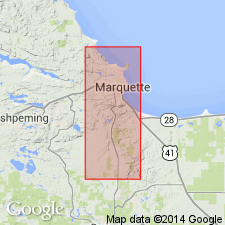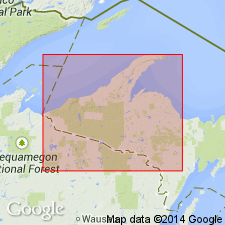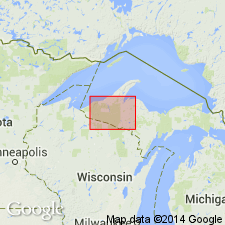
- Usage in publication:
-
- Menominee group*
- Modifications:
-
- Reinstated
- Revised
- AAPG geologic province:
-
- Lake Superior region
Summary:
Pg. 30 (table 1), 35. Menominee group. Reinstated and redefined as group in Animikie series. As redefined, covers only middle part of series as originally defined by Bayley (USGS Monograph 46, 1904). In type locality, group includes two formations (ascending): Felch formation; and Vulcan iron-formation made up of (ascending) Traders iron-bearing member, Brier slate member, Curry iron-bearing member, and Loretto shale member. Unconformably underlies Baraga group (new); unconformably overlies Chocolay group (new). Present mostly in Iron and Dickinson Counties, northwestern Michigan (Lake Superior region). Age is middle Precambrian (Animikie Series). Report includes stratigraphic sequence chart.
Source: US geologic names lexicon (USGS Bull. 1200, p. 2460-2461); supplemental information from GNU records (USGS DDS-6; Reston GNULEX).

- Usage in publication:
-
- Menominee Group*
- Modifications:
-
- Revised
- AAPG geologic province:
-
- Lake Superior region
- Wisconsin arch
Summary:
Pg. 46-49. Menominee Group of Animikie series. Includes (ascending) Ajibik Quartzite and Siamo Slate in the Marquette area, Marquette and Sands 7.5-min quadrangles, Marquette County, northwestern Michigan (Lake Superior region). Overlies Chocolay Group with unconformity or disconformity. Age is middle Precambrian (Animikie Series).
Source: Publication; Changes in stratigraphic nomenclature, 1968 (USGS Bull. 1294-A, p. A12).

- Usage in publication:
-
- Menominee Group*
- Modifications:
-
- Revised
- AAPG geologic province:
-
- Lake Superior region
Summary:
Pg. 2844, 2845 (fig. 2, stratigraphic chart compiled from Leith and others, 1935; James, 1958; Gair and Thaden, 1968). Menominee Group of James (1958) reassigned to newly named Marquette Range Supergroup (replaces †Animikie series of James, 1958, south of Lake Superior, in Michigan and Wisconsin). In Marquette Range, includes (ascending) Ajibik Quartzite, Siamo Slate, and Negaunee Iron-Formation. In Menominee Range, includes (ascending) Felch Formation and Vulcan Iron-Formation. In Gogebic Range, includes (ascending) Palms Quartzite and Ironwood Iron-Formation. Absent in Iron River-Crystal Falls district. Nonconformable contacts with overlying Baraga and underlying Chocolay Groups. Is probably correlative with Animikie Group of Gunflint Range, Ontario, Canada, and Mesabi Range, Minnesota. Age is middle Precambrian.
Source: Publication.

- Usage in publication:
-
- Menominee Group*
- Modifications:
-
- Overview
- AAPG geologic province:
-
- Lake Superior region
Summary:
Is middle group (of 3) of the middle Precambrian Marquette Range Supergroup. "Metasedimentary rocks of middle Precambrian age form a belt across the southern part of the quadrangle and underlie the Dead River basin in the central and western parts of the quadrangle. The rocks belong to the Chocolay, Menominee, and Baraga Groups of the Marquette Range Supergroup (Cannon and Gair, 1970) and are unconformable on lower Precambrian rocks." The Menominee Group comprises the Ajibik Quartzite, the Siamo Slate, and the Negaunee Iron-Formation as mapped in the Negaunee quadrangle, Marquette Co, MI (Lake Superior region). Ajibik averaging 150 ft thick; Siamo 1,500 to 2,000 ft thick; and Negaunee greater than 2,000 ft thick.
Source: GNU records (USGS DDS-6; Reston GNULEX).

- Usage in publication:
-
- Menominee Group*
- Modifications:
-
- Revised
- AAPG geologic province:
-
- Lake Superior region
Summary:
Units formerly assigned to Baraga Group (Amasa, Fence River, and Hemlock Formations, all revised) now included in revised Menominee Group of Marquette Range Supergroup. Present in Iron River and adjacent areas, northwest MI in the Lake Superior region. Unconformably underlies revised Baraga Group and disconformably? overlies Chocolay Group. Is Early Proterozoic in age.
Source: GNU records (USGS DDS-6; Reston GNULEX).
For more information, please contact Nancy Stamm, Geologic Names Committee Secretary.
Asterisk (*) indicates published by U.S. Geological Survey authors.
"No current usage" (†) implies that a name has been abandoned or has fallen into disuse. Former usage and, if known, replacement name given in parentheses ( ).
Slash (/) indicates name conflicts with nomenclatural guidelines (CSN, 1933; ACSN, 1961, 1970; NACSN, 1983, 2005, 2021). May be explained within brackets ([ ]).

